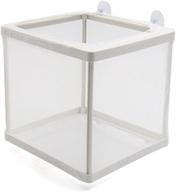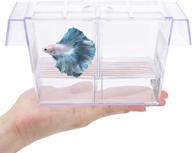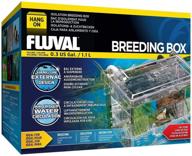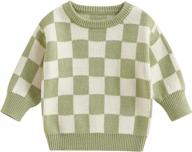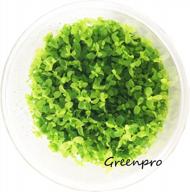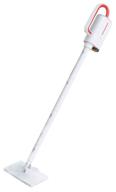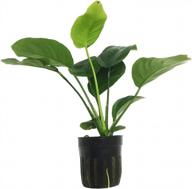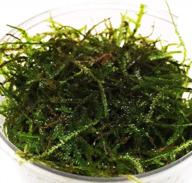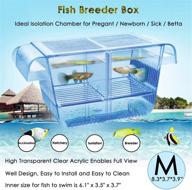Top products in 🦐 Fish Breeding Tanks
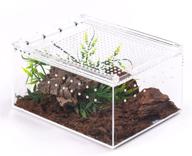

8 Review

How to set up a refugium breeder box for optimal results?
Setting up a hang-on refugium breeder box can provide many benefits for your aquarium, but getting the proper setup is key. Here are some tips for setting up a refugium breeder for optimal results:
Choose the right location
Pick a spot on the back or side of your main display tank where the breeder box will easily hang on the rim. Make sure it's positioned where you can easily access inside the breeder.
Add substrate
Add 1-2 inches of fine substrate like sand or small gravel at the bottom of the breeder box. This gives a place for helpful bacteria to colonize and provides an appropriate environment for species like shrimp or fry.
Install water flow
Use an air-powered sponge filter or small water pump to pull water from the main tank into the breeder box. This circulates clean, oxygenated water through the system.
- Aim for a gentle turnover rate of 4-5 times per hour.
- Make sure the water enters the breeder box quietly to avoid stress.
Maintain proper water parameters
Test and adjust as needed to match the temperature, pH, hardness, etc. of the display tank. This provides consistency for sensitive species.
Cycle the breeder box
Allow 2-6 weeks to fully cycle the breeder before adding any livestock. Monitor ammonia and nitrite levels and do partial water changes as needed.
Following these tips will help you get your refugium breeder box fully prepared to provide a healthy and productive supplemental habitat on your main aquarium.
Another interesting products
How to use a hang on breeder box to raise baby fish or shrimp?
Hang on breeder boxes are a great tool for raising baby fish or shrimp in an aquarium. Here are some tips on using them effectively:
Select the breeder box
Choose a breeder box designed for hang on use, with a built-in water flow system. Opt for an appropriately sized box based on the number of babies you intend to raise.
| Breeder Size | Recommended Use |
|---|---|
| Small (1-2 gallons) | 10-20 baby shrimp or fry |
| Medium (3-5 gallons) | 30-50 baby shrimp or fry |
| Large (5-10 gallons) | 50-100 baby shrimp or fry |
Set up the breeder box
Install the breeder box on the rear or side glass of the main tank. Add substrate, plants, hides and air/water flow as needed to create an ideal habitat.
Acclimate the babies
Slowly introduce the baby shrimp or fish to the breeder box. Monitor them closely at first to ensure they are settled and eating well.
Provide proper care
- Feed babies 2-3 small meals daily with powdered fry food, shrimp pellets or infusoria.
- Test and maintain excellent water quality. Do 10-20% water changes 1-2 times per week.
- Remove debris and algae buildup with siphon or algae scrubber regularly.
Using best practices when setting up and maintaining a hang on breeder box can help raise healthy, fast-growing babies! They will eventually be ready for the main tank once they mature.
Similar products
What are the benefits of using an external refugium on your aquarium?
Adding an external refugium to an aquarium provides a variety of advantages over the main tank alone:
Improved Water Quality
A refugium grows macroalgae such as chaetomorpha that absorbs nitrate, phosphate and other pollutants from the water. This takes pressure off the main system and keeps water cleaner for fish and corals.
Added Filtration
Along with macroalgae, refugiums also house populations of copepods, amphipods and other microfauna that provide natural biological filtration to reduce waste and decompose organic matter.
Increased Biodiversity
External refugiums create space for a wider variety of beneficial species to thrive, such as pods, isopods, mollies, shrimp and more. This adds diversity to the entire aquarium habitat.
Raising Fry/Larvae
The separate, highly controlled environment allows for successfully raising sensitive fry that may get eaten in the main tank. Refugiums are ideal for breeding fish, corals, shrimp, etc.
Quarantine/Treatment
- Use refugiums to observe new fish in quarantine to prevent introducing disease.
- Treat sick fish in the refugium with medications away from main tank inhabitants.
Stable Conditions
Heating, lighting, flow rates and other parameters can be independently optimized to provide consistent, ideal conditions for all inhabitants across both the main tank and refugium.
Make the most of your aquarium ecosystem by adding an external refugium for natural filtration and expanded habitat space!
Tips for getting the most out of your Finnex hang on breeder box
Finnex makes high quality hang on breeder boxes that can be extremely useful for aquarists. Here are some tips to optimize these systems:
Set Up Properly
- Install securely on tank rim with clamps tightened appropriately.
- Add 1-2 inches of fine gravel substrate.
- Supplement with sponge filter, air stone or small powerhead for water flow.
- Use egg crate to partition box if raising multiple species.
Cycle Completely
Allow 4-6 weeks to fully cycle the breeder box before adding any livestock. Test for zero ammonia and nitrites to confirm the nitrogen cycle has established.
Match Water Parameters
Ensure temperature, pH and hardness match the main tank. Acclimate species slowly to prevent shock when transferring.
Feed Appropriate Diet
Offer newly hatched brine shrimp, infusoria, pellet crumbs or powdered fry food 2-3 times daily to fit the small size of fry or shrimp.
Perform Regular Maintenance
- Siphon debris from gravel substrate weekly.
- Check water flow devices to prevent clogging.
- Wipe down box walls with algae scrubber to allow light penetration.
Quarantine New Brood Stock
Use the breeder to quarantine new adult shrimp or fish for 4-6 weeks before adding to the main tank to prevent disease issues.
Following these tips will lead to happier, healthier inhabitants and maximize the value of your Finnex hang on breeder box.
How to connect a water pump to a hang on breeder box for proper water flow?
Providing the right amount of water circulation is important for a healthy breeder box environment. Here is how to connect a water pump properly:
Select an Appropriate Pump
Choose a compact, submersible water pump that is rated for aquarium use. Opt for one with an adjustable flow rate in the range of 50-150 gallons per hour.
Determine Tubing Size
The pump outflow and breeder box inflow tubing diameter should match the connectors on the pump itself. Standard sizes are 1/2" ID or 5/8" ID flexible tubing.
Connect Tubing to Pump
Attach the flexible tubing to the outflow side of the water pump using hose clamps for a tight, leak-proof seal.
Install Inflow Tube
Place the other end of the tubing into the breeder box input. Secure it with suction cups and position it near the bottom for circulation throughout the water column.
Power the Pump
Connect the pump to a power source like an air pump outlet, power strip or DC converter. Make sure any electrical components are properly rated and installed for aquarium use.
Adjust Flow Rate
Monitor water movement and make flow adjustments via the pump impeller or tube diameter as needed. Target around 4-5 tank turnovers per hour.
Perform Routine Maintenance
- Clean pump impeller and tubing regularly to prevent clogging.
- Check tubing clamps and suction cups to ensure tight seals.
- Replace worn pump parts for optimal performance.
Properly integrating a water pump establishes ideal water circulation for a healthy and productive breeder box environment.
Getting the Most Out of Your Amazon Prime Subscription
Amazon Prime comes with many perks that savvy shoppers can utilize to maximize their membership. Here are some tips:
Take Advantage of Free Shipping
Get free two-day shipping on over 100 million products. Plan purchases accordingly to avoid paying extra for expedited delivery.
Leverage Amazon Prime Day
Time purchases right to catch major sales on popular items during Amazon's annual Prime Day event in July.
Utilize Prime Video Extensively
Stream an expansive collection of movies, TV shows and Amazon Originals without paying for premium streaming services.
Read Ebooks with Prime Reading
Access a rotating selection of books, magazines, comics and more to enjoy without buying individually.
Listen Ad-Free with Prime Music
Get access to over 2 million songs and thousands of playlists to stream or download without interruptive ads.
Shop Exclusive Prime-Member Deals
Take advantage of daily deals and discounts that are only available with a Prime membership.
Using tips like these can help you maximize your Prime subscription ethically and get the most for your membership dollars.
How To Install Finnex Hang-On Box External Refugium Breeder With Water Pump?
Here are the steps to install the Finnex Hang-On Box External Refugium Breeder with Water Pump:
- Unpack the Finnex Hang-On Box External Refugium Breeder with Water Pump and make sure all the accessories are included.
- Choose a suitable location for the box to hang on the back of your aquarium.
- Attach the box to the back of your aquarium using the hanger provided.
- Install the water pump by attaching it to the box and adjusting the flow rate as needed.
- Add any additional accessories, such as the Finnex Ultra Slim LEDs, to enhance the functionality of the box.
- Adjust the dividers as needed to create separate compartments for breeding, refugium, or quarantine purposes.
What Are The Dimensions Of Finnex Hang-On Box External Refugium Breeder With Water Pump?
The dimensions of the Finnex Hang-On Box External Refugium Breeder with Water Pump are:
The box has a capacity of 0.8 gallons. The dimensions are consistent across multiple sources.
What Is The Capacity Of Finnex Hang-On Box External Refugium Breeder With Water Pump?
The capacity of the Finnex Hang-On Box External Refugium Breeder with Water Pump is 0.8 gallons. This information is consistent across multiple sources.





